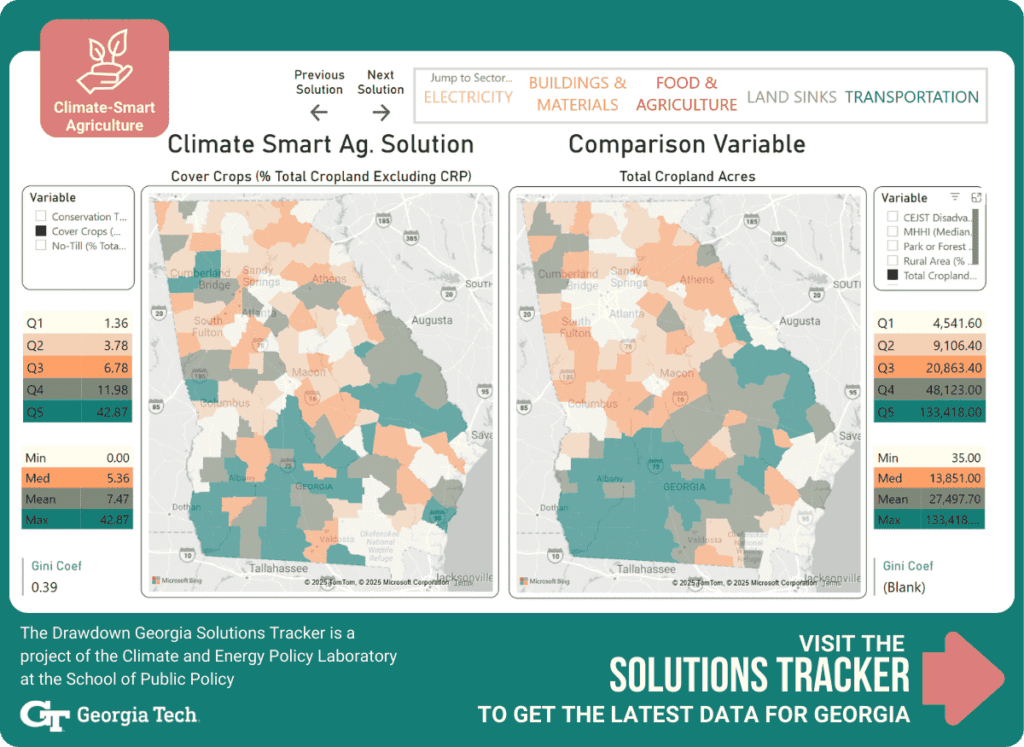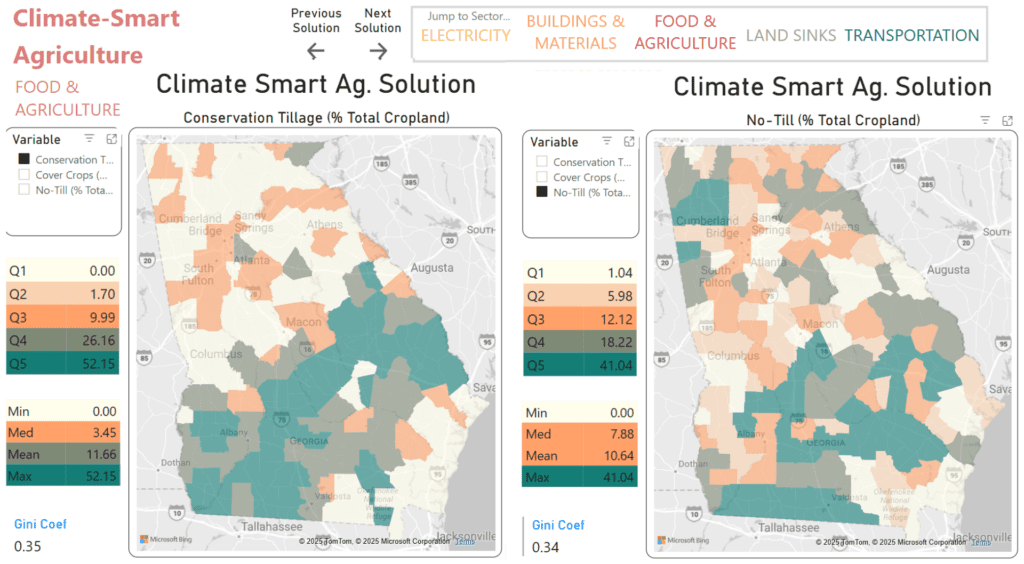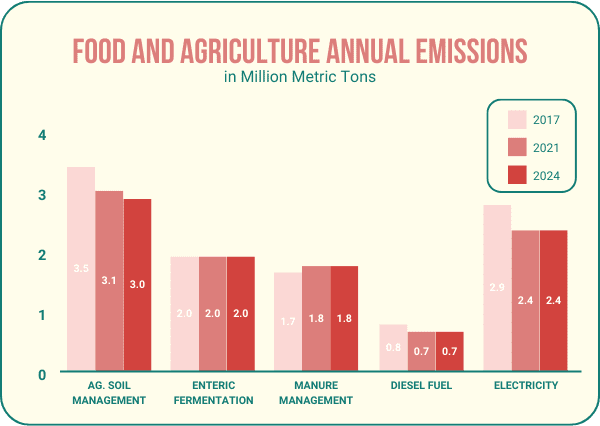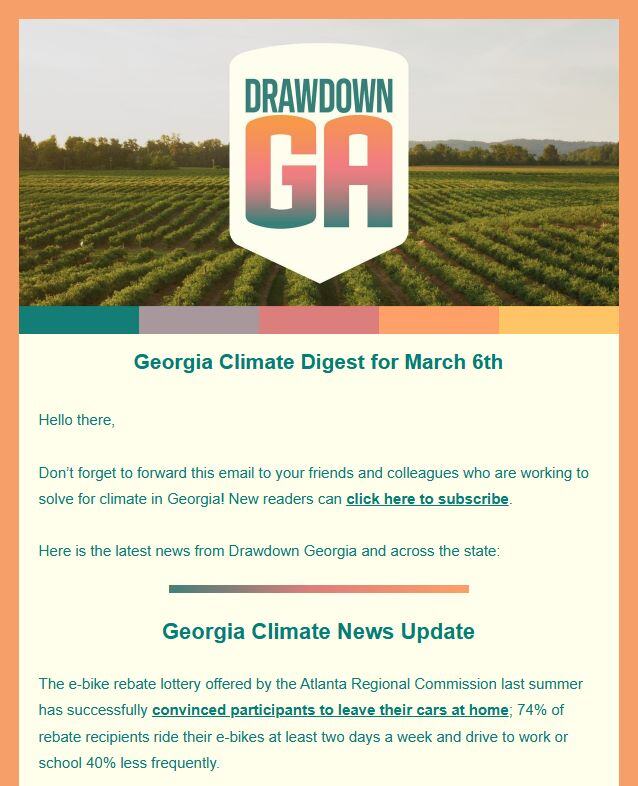The Benefits of Climate Smart Agriculture
Climate Smart agriculture refers to a set of agricultural practices that support carbon sequestration via crop rotation, managing soil organic matter, and reduced tillage.
Access Climate Smart Resources from Drawdown Georgia
Climate Smart Agricultural Practice: Cover Cropping
Cover crops are grasses, legumes, and herbaceous flowering plants that increase soil carbon sequestration by increasing biomass where they are planted. This intervention can also increase organic matter in the soil and offset the need for synthetic nitrogen fertilizers. Cereal rye and winter wheat are the most widely planted cover crops.

Cover cropping is associated with the highest per-acre greenhouse gas emissions reductions, with average reductions of 0.508 MT CO2e per year. Cover cropping varies in effectiveness depending on the type of cover crop (legume versus non-legume), the fertilizer reduction supported by boosted soil health, tillage rates, and whether or not the cropland is irrigated.
Climate Smart Agricultural Practice: No-Till Farming
No-till farming consists of managing the amount, orientation, and distribution of crop and other plant residue on the soil surface year-round while limiting the soil-disturbing activities like tilling before planting. Tillage has been demonstrated to increase carbon dioxide emissions from soil, whereas practices that reduce soil disturbance or increase organic matter carbon inputs can sequester carbon in the soil.

Conservation tillage can reduce emissions by an average of 0.192 MT CO2e per acre per year, and no-tillage nearly doubles the emissions reductions to an average of 0.369 MT CO2e per acre per year. There is a greater climate impact for systems that are irrigated compared to those that are not irrigated.
Market Readiness And Available Technology
The Inflation Reduction Act (IRA) shifted USDA funding patterns, significantly expanding investments in climate-smart agriculture. Among the key provisions, the Environmental Quality Incentives Program (EQIP) received $8.45 billion, while the Conservation Stewardship Program (CSP) was allocated $3.25 billion. These funding patterns are subject to change.
Both programs now include explicit climate “guardrails,” requiring that funded practices directly contribute to emissions reductions by improving soil carbon, reducing nitrogen losses, or sequestering carbon dioxide, methane, or nitrous oxide. The Agricultural Conservation Easement Program (ACEP) and the Regional Conservation Partnership Program (RCPP) also saw increased funding, allowing for the protection of farmland and wetlands while supporting conservation projects that enhance soil carbon sequestration and mitigate greenhouse gas emissions.
These programs provide direct financial support to farmers to adopt conservation practices such as cover cropping, reduced tillage, and conservation crop rotations, which can contribute to long-term emissions reductions.
Beyond direct farmer incentives, the IRA also invests in research, technology, and infrastructure supporting climate-smart agriculture. It dedicates $1 billion for technical assistance through the Natural Resources Conservation Service (NRCS); $250 million for research, education, and extension efforts; and an additional $125 million for technical assistance targeting underserved farmers, ranchers, and foresters. This funding is also subject to change.
The USDA’s Greenhouse Gas Inventory and Assessment Program received new funding to improve carbon sequestration measurement methodologies. The act also includes $14 billion for rural development, including renewable energy initiatives and biofuel infrastructure, which could further reduce agricultural emissions.
Climate Smart Agriculture as a Climate Solution in Georgia
The Drawdown Georgia research team estimates that our state could reduce emissions by one megaton (Mt) of CO2e by adapting an additional 1.6 million acres of cropland into conservation agriculture practices in Georgia.
Achievable Reduction Potential by 2030 / What Could We Achieve In Carbon Emissions Reductions by 2030?
Achievable reduction potential is derived by taking the technical reduction potential, outlined below, and developing a more realistic forecast that takes current rates of deployment, market constraints, and other barriers into consideration.
For climate smart agriculture, the Drawdown Georgia research team has calculated the achievable reduction potential to be 0.26 Mt of CO2e.
Technical Reduction Potential by 2030 / What Is the Upper Limit of Potential?
Technical reduction potential reflects the upper limit of emissions reductions for this solution without regard to the constraints that exist in the real world, such as economic or political considerations.
For climate smart agriculture, the Drawdown Georgia research team has calculated the technical reduction potential to be 0.7 Mt.
Current State of Climate Smart Agriculture in Georgia
The maps above show a strong positive correlation between the use of conservation practices and acres of cropland. This is good news in that where we see a lot of active farmland, we also see a lot of conservation practices. It is also a testament to the impact that years of education, technical assistance, incentive payments, and cost-sharing efforts through EQIP, CSP, ACEP, and RCPP have had on agricultural practices in Georgia.

Given the number of years these programs have been operating, however, it is important to ask if the current adoption rate represents the maximum uptake. Enhanced funding through the IRA could provide an answer to that question.
How Reliable Is Our Estimate For This Drawdown Georgia Climate Solution?
Many farmers already use reduced tillage practices and cover crops. Those who use reduced tillage practices often alternate them with conventional tillage. According to Project Drawdown®, conservation agriculture practices increase the carbon sequestration rate at an average of 0.2 tons of CO2e per acre per year. Georgia has about 3.8 million acres of croplands, of which about 47% are under conservation tillage practices. If another 40% of the land were converted into conservation tillage, the CO2 sequestration potential could be about 1.1 Mt CO2-e per year.
Cost Competitiveness
Cost varies based on the type of crops and yield potential. In the literature, there is limited data related to conservation tillage practices for specific crop types. The farm-specific conservation measures and the associated costs can be estimated by the procedures from Gordon (2013). In general, conservation agriculture practices save costs for farmers.
Beyond Carbon Attributes
This solution improves water quality and quantity while also lowering soil erosion and improving soil health. Excess water runoff is minimized by better soil protection, reducing water use and the carrying of fertilizer contaminating water. Soil quality is improved by reducing the loss of organic material and improving/maintaining the original soil porosity, resulting in higher resistance to drought. Farmers may experience increases in crop/agricultural yield and thus increases in income and wages.
When plants have a better opportunity to grow healthily from the extension of water and plant nutrients, yields have been reported to increase anywhere between 20%-120% with lower energy and production costs. Water quality improvements can increase public health and raise the quality of life for farmers and rural communities, and upfront costs for farmers would be low if agricultural systems are already in place.
A negative impact of this solution is the difficulty in changing farmers’ perceptions that conservation agriculture lowers yield and income. Interventions such as subsidies and interest groups continue to discourage farmers from adopting no-tillage practices,stagnating the preference for conservation agriculture.



